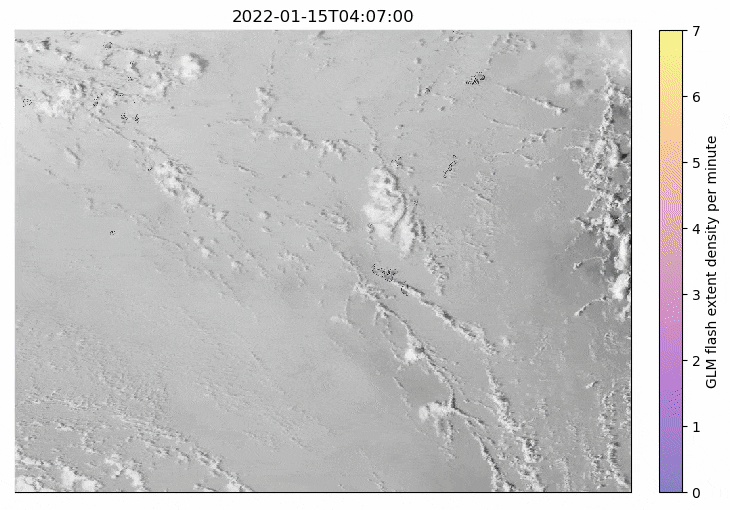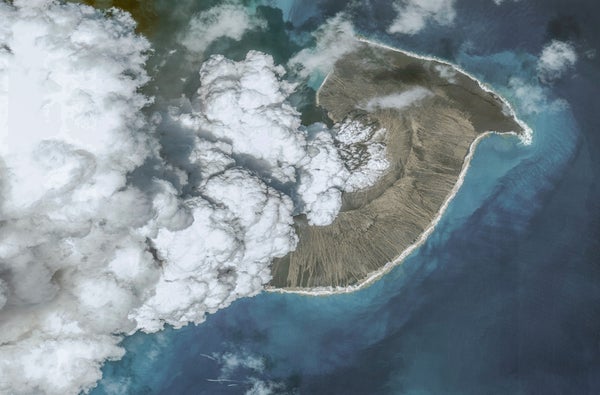The Hunga Tonga-Hunga Ha'apai volcanic eruption, which produced the most powerful atmospheric explosion ever recorded, also generated a record number of lightning strikes in a supercharged thunderstorm that lasted 11 hours and spread across 150 miles (240), a new study reports.
The volcano, which is located in the southern Pacific Ocean, began erupting in December 2021, but its most explosive event did not occur until Jan. 15, 2022. Despite the volcano's caldera being 500 feet (150 meters) below sea level, the blast burst through the water and sent a plume of ash towering 36 miles (58 km) high, with an eruption rate of 11 billion pounds (5 billion kilograms) per second — an order of magnitude greater than the Mount St. Helens eruption in May 1980.
"There are theoretical limits for how high a plume can go and how fast the eruption rate can be, and the Hunga Tonga eruption just smashed them all," the study's lead author, Alexa Van Eaton of the U.S. Geological Survey, told Space.com.
On supporting science journalism
If you're enjoying this article, consider supporting our award-winning journalism by subscribing. By purchasing a subscription you are helping to ensure the future of impactful stories about the discoveries and ideas shaping our world today.
Another record the eruption shattered was the number of lightning strikes. The plume produced the most intense lightning storm ever seen, with 2,600 flashes per minute at its peak and totaling about 192,000 flashes over the course of 11 hours. What's more, this lightning storm took place at an unprecedented altitude of between 12 and 19 miles (20 to 30 km), higher than any lightning has been seen before. These lightning strikes were detected by both a network of radio antennae designed to track storms and two Earth-orbiting spacecraft, the
GOES-17 satellite operated by the U.S. National Oceanic and Atmospheric Administration (NOAA) and the Japanese Meteorological Agency's Himawari-8 satellite.
"We've never seen anything like this sheer rate of lightning before, and at such high altitudes," Van Eaton said.

Animation of lightning flashes and GOES-17 satellite images on January 15, 2022. Blue dots show each lightning flash location from the combined, ground-based radio network data. The purple-yellow color scale shows optically detected lightning from a sensor onboard GOES-17, indicating the number of optical flashes per grid cell per minute. Credit: “Lightning Rings and Gravity Waves: Insights Into the Giant Eruption Plume From Tonga's Hunga Volcano on 15 January 2022” by Alexa R. Van Eaton et al., in Geophysical Research Letters, Published online June 20, 2023
The satellite imagery shows that the lightning wasn't randomly spread across the plume but rather occurred in several concentric rings that seemed to be linked to each explosive outburst from the volcano. As the plume rose upward, it billowed out to form an "umbrella cloud," with overspilling material falling down onto it and oscillating around a layer of neutral buoyancy.
"This imparted a vertical motion into the cloud so huge that the wave, moving outward from the center of the plume, was 10 vertical kilometers [6 miles] from crest to trough," said Van Eaton. This oscillating pressure wave, also known as a gravity wave (not to be confused with gravitational waves from merging black holes or neutron stars), was the source of the lightning.
There are two ways the lightning may have formed within this ring-shaped gravity wave. Since the Hunga Tonga eruption took place underwater, it injected lots of water into Earth's atmosphere, the resulting ice crystals adopting positive and negative charges. In addition, some of the volcanic ash that was formed of fragmented rock and magma blown into the air by the eruption also become ionized, leading to more areas of positive and negative charge. It's the gradient in electrical charge that sets off sudden sparks of lightning.
While lightning rings have been seen in volcanic plumes before, the Hunga Tonga eruption was the first time multiple rings had been seen — four in total, matching the four phases of the volcano's eruption — and the lightning rode the rippling rings like a surfer on ocean waves.
Lightning rings are also termed "lightning holes," because inside the ring there usually is no lightning. However, this was just another way in which the Hunga Tonga eruption was different: the holes started filling with lightning within minutes of the gravity wave rippling by. The mechanism that prompted this infilling remains unclear.
Regardless, the presence of lightning highlights how electrical flashes could be used to provide early warning of an eruption. Normally, volcanologists must wait 10 or so minutes for an orbiting satellite to detect and image a volcanic plume and emergency services to be alerted, by which time resulting tsunamis may have drowned coastal regions, hurricane winds flattened trees and homes, pyroclastic flows wiped out tens of square miles and ash bunged up aircraft jet engines. Lightning strikes, however, are detected at radio frequencies at the speed of light. It goes without saying that this is faster than satellites, winds, seismic waves and infrasound.
Besides breaking records in the present day, the Hunga Tonga eruption could also teach us about volcanism on the early Earth, and even potentially on other celestial bodies. The eruption is a type referred to as a phreatoplinian volcano, which occurs when a huge amount of molten rock erupts through a thick layer of water. An explosive underwater volcano on this scale has only previously been seen in the geological record.
Furthermore, the eruption could "plausibly have implications for the way that lightning gets going on other planets, such as Venus, or other planetary bodies that wouldn't typically support traditional lightning," said Van Eaton.
Evidence of active volcanism on Venus was discovered earlier this year, in archive data from NASA's Magellan mission to the second planet from the sun. However, volcanism is plentiful on the Jupiter moon Io, while forms of cryovolcanism occur on the Saturn moon Enceladus and possibly also the Jovian satellite Europa.
"Enceladus has major water jets that just shoot off. Could they support lightning?" wondered Van Eaton. "I don't know, but it seems that this is a way to create a major atmospheric perturbation that we haven't really been thinking about for other worlds."
The research was published online today (June 19) in the journal Geophysical Research Letters.
Copyright 2023 Space.com, a Future company. All rights reserved. This material may not be published, broadcast, rewritten or redistributed.
